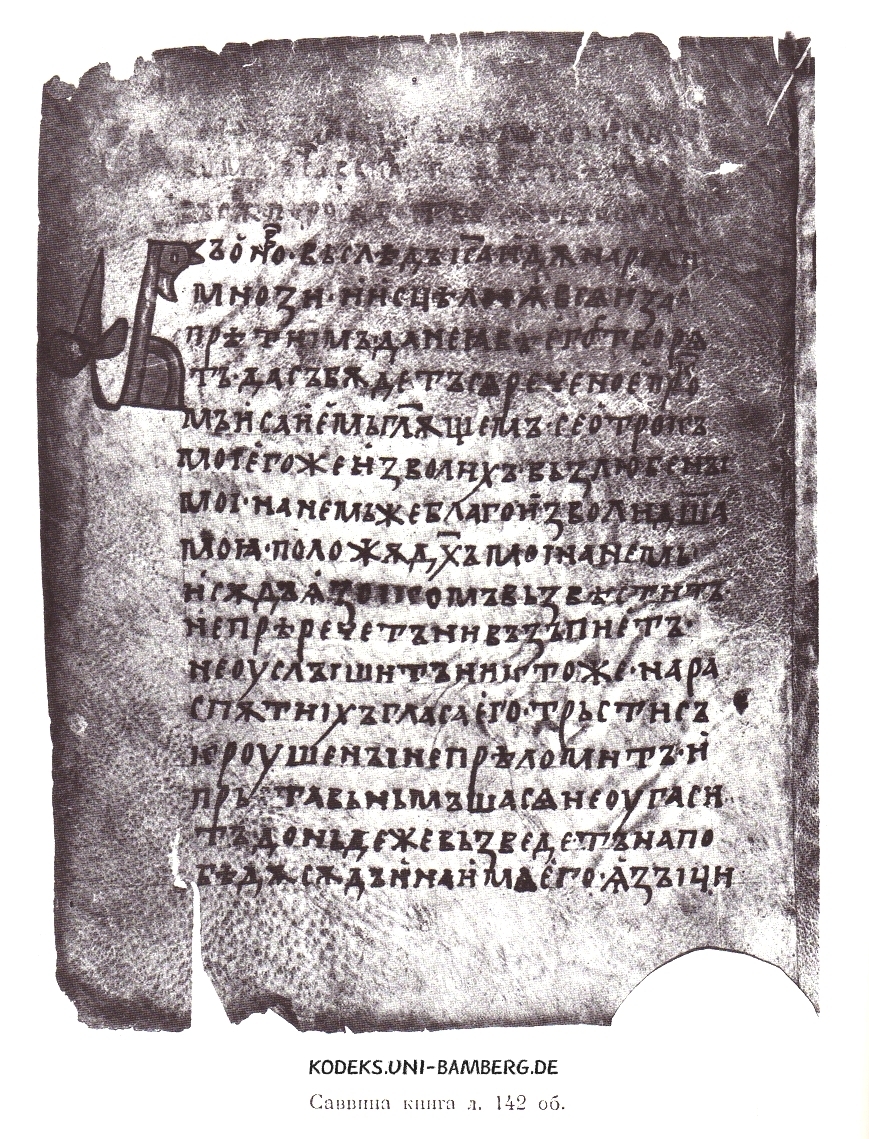Sava's Book on:
[Wikipedia]
[Google]
[Amazon]
 Sava's book (; ) is a 129-folio
Sava's book (; ) is a 129-folio
Scans of the 1903 Ščepkin's edition
Facsimile of the manuscript
(РГАДА)
 Sava's book (; ) is a 129-folio
Sava's book (; ) is a 129-folio Cyrillic
The Cyrillic script ( ) is a writing system used for various languages across Eurasia. It is the designated national script in various Slavic, Turkic, Mongolic, Uralic, Caucasian and Iranic-speaking countries in Southeastern Europe, Ea ...
Old Church Slavonic
Old Church Slavonic or Old Slavonic ( ) is the first Slavic languages, Slavic literary language and the oldest extant written Slavonic language attested in literary sources. It belongs to the South Slavic languages, South Slavic subgroup of the ...
canon
Canon or Canons may refer to:
Arts and entertainment
* Canon (fiction), the material accepted as officially written by an author or an ascribed author
* Literary canon, an accepted body of works considered as high culture
** Western canon, th ...
evangeliary, written in the 11th century.
The original 126 parchment
Parchment is a writing material made from specially prepared Tanning (leather), untanned skins of animals—primarily sheep, calves and goats. It has been used as a writing medium in West Asia and Europe for more than two millennia. By AD 400 ...
folios are of Bulgarian provenance, being bound into a larger codex with later additions of the Russian Church Slavonic recension. The codex is named the priest Sav(v)a, who inscribed his name on two of the original folios. There is no other historical record of Sava, and it is therefore believed that he was one of the manuscript's copyists.
The early history of Sava's book is unknown. What can be ascertained is that the codex was in the Seredkino monastery near Pskov
Pskov ( rus, Псков, a=Ru-Псков.oga, p=psˈkof; see also Names of Pskov in different languages, names in other languages) is a types of inhabited localities in Russia, city in northwestern Russia and the administrative center of Pskov O ...
until at least the 17th century. Afterwards it was moved to the manuscript collection of the Moscow Synodal Printing House, where it was found in 1866 by the Russian Slavist Izmail Sreznevsky, who gave the codex its modern-day appellation and was the first one to publish it in Saint Petersburg in 1868. Today it is kept in the Russian State Archives of Ancient Documents in Moscow.
The first critical edition of the manuscript was published by V. N. Ščepkin (''Savvina kniga'', Saint Petersburg 1903), photographically reprinted in Graz in 1959. Ščepkin was the first to perform a paleolinguistic analysis of the manuscript (''Razsuždenie o jazyke Savvinoj knigy'', 1899), and he ascertained that it was copied from a Glagolitic
The Glagolitic script ( , , ''glagolitsa'') is the oldest known Slavic alphabet. It is generally agreed that it was created in the 9th century for the purpose of translating liturgical texts into Old Church Slavonic by Saints Cyril and Methodi ...
original. His 1903 edition led N. Karinski to propound several new readings and to fix some wrong solutions (''Perečenь važnejših netočnostei poslednego izdanija Savvinoj knigi'', Izv., XIX, 3, 206-216). Paleographic and linguistic analysis shows that the copyist wrote yers where he did not pronounce them anymore, and that behind ''č'', ''ž'' and ''š'' he wrote ''ъ'' instead of ''ь'', which indicates that the aforementioned consonants were pronounced "hard" in the scribe's mother tongue, or, more likely, that other than the preserved softness in the preceding consonant the two yers had merged. There is abundant evidence for the loss of epenthetic ''l'', and, instead of iotated a (), yat
Yat or jat (Ѣ ѣ; italics: ''Ѣ ѣ'') is the thirty-second letter of the Early Cyrillic alphabet, old Cyrillic alphabet. It is usually Romanization, romanized as E with a haček: ''Ě ě''.
There is also another version of y ...
() is often written.
See also
* Codex Zographensis * Psalterium Sinaiticum * Codex Marianus * Glagolita ClozianusReferences
* * {{cite book, last= Schenker, first= Alexander , author-link=Alexander M. Schenker , title=The Dawn of Slavic: An Introduction to Slavic Philology , publisher=Yale University Press , location= New Haven , year= 1995 , isbn=0-300-05846-2External links
Scans of the 1903 Ščepkin's edition
Facsimile of the manuscript
(РГАДА)
Sava
The Sava, is a river in Central Europe, Central and Southeast Europe, a right-bank and the longest tributary of the Danube. From its source in Slovenia it flows through Croatia and along its border with Bosnia and Herzegovina, and finally reac ...
Old Church Slavonic canon
11th-century biblical manuscripts
Medieval Bulgarian literature
Bulgarian manuscripts
Cyrillo-Methodian studies